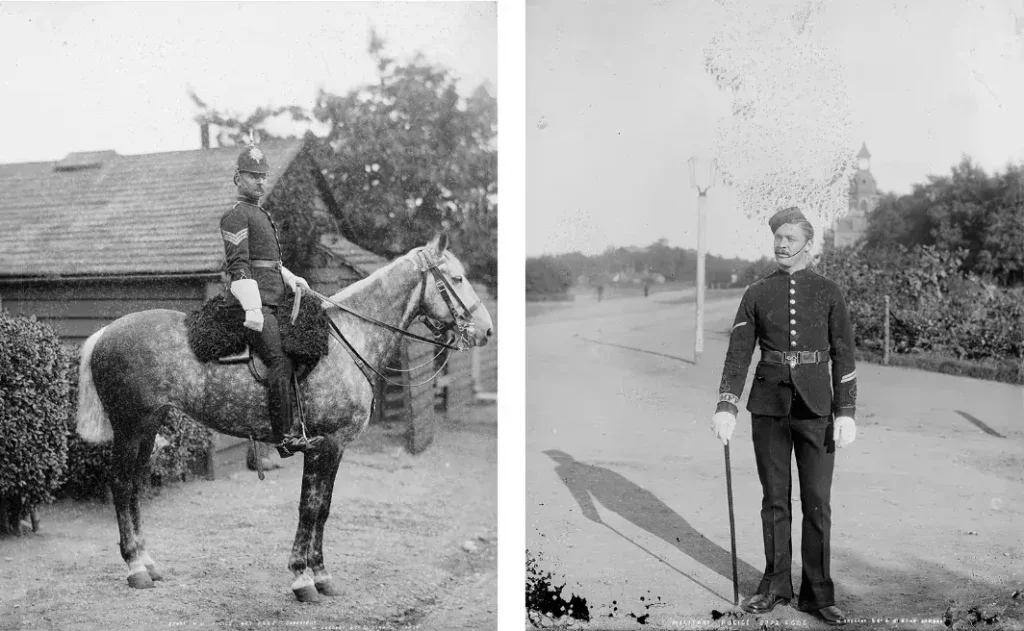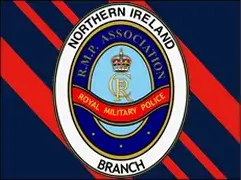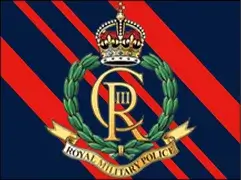
The History of the Royal Military Police
Ancestors of the modern Royal Military Police
Britain’s Royal Military Police claims to have a tradition of service to the Crown and Nation longer than any regiment of corps with an antecedence stretching back to at least 1241, when Henry II appointed one William of Cassingham as a Military ‘Sergeant of the Peace’. He and his Under-Provosts were the ancestors of the modern Royal Military Police.
Provost Companies
As the Provost Marshal’s office gradually assumed increased duties of a policing nature within the Army, he was provided with State-paid troops, referred to in Henry VIII’s day as Provost Companies the term still used today to describe a formed body of Military Police.
The first recorded Provost Marshal in English history of whom there is a personal record, is one Sir Henry Guldeford (or Guylford) appointed in 1511. The Provost Marshal was responsible for maintaining discipline within the English armies together with the King’s personal security. He was also described as the ‘first and greatest gaoler of the Army’.
Britain’s first standing military police force came into being in 1813, when the Duke of York, Commander-in-Chief of the British Army proposed the formation of a Staff Corps of Cavalry to be attached to the Adjutant-General.
Commanding Officers of Cavalry Regiments were then ordered to submit the names of soldiers to serve in this new unit, detachments of which were allotted to each division of the Peninsular Army, similar to today’s Provost Companies, which allocated to every manoeuvre and logistic brigade.
The Red Cap
Wellington asked for a Provost Marshal to be appointed to hang looters and by the end of the Peninsular War the Provost Marshal controlled 24 Assistant Provost Marshals. The Assistants were also authorised to hang offenders and eventually each division had its own Assistant Provost Marshal.
Until a uniform was approved, members of the Staff Corps of Cavalry were identified by a red scarf tied around the right shoulder of their original uniform, which while some consider this to have been the origin of the famous ‘Red Cap’ of the Royal Military Police and its forebears, it was certainly the most likely precursor of the ‘MP’ armband (and now the Tactical Recognition Flash), which identifies the modern Military Policeman or Policewoman.
Although disbanded in 1814 at the end of the Peninsular War, following Napoleon’s defeat at the battle of Waterloo the Duke of Wellington re-formed the Staff Corps of Cavalry to police the occupying British Army in France. Later, in the Crimean War, a Mounted Staff Corps comprised of almost 100 troopers from the Police Constabulary of Ireland, with some recruited from the Metropolitan Police, was established to prevent the theft of supplies and to maintain discipline in camps. This ‘Corps’ was disbanded with the cessation of hostilities.
Mounted Military Police
Back at home, a Mounted Military Police (MMP) Corps was formed of man with ‘at least 5 years’ service of sober habits, intelligent, active and discreet’ on 13th June 1855, to police the new Army cantonment at Aldershot. This development was the beginning of the existing organisation of the Corps of Military Police.
On 1 August 1877, the Military Mounted Police was formerly established as a distinct Corps for service both at home and abroad, and it is from this date that the RMP claims its current place in the British Army’s ‘Order of Battle’. In 1882, a Military Foot Police (MFP) was raised as a separate Corps for service in Egypt.
An enormous expansion of the MMP and the MFP role saw the number of troops engaged on Provost related tasks increased to about 25,000 all ranks by the end of the First World War, where the Military Police had begun to be employed on operational tasks: route control; host-nation liaison; and straggler control.
In 1927, the MMP and the MFP were amalgamated to form the Corps of Military Police (CMP) with an initial strength of 508 all ranks, the same as the combined strength of the two units before the war in 1914.
In the 1930s CMP was radically reorganised: in 1935 Provost companies and sections were formed with fixed establishments, in 1937, a Field Security Wing (the ‘Green Hats’) was formed, although it was transferred to a new Intelligence Corps in 1940, some 800 Automobile Association scouts joined the Supplementary reserve of the CMP between 1938 and the outbreak of war; and again in 1938 direct enlistment from civilian life into CMP was allowed for the first time.
Second World War
During the Second World War, the Corps expanded from its pre-war peacetime establishment of 4,121 to over 32,000 by 1943, seeing service in all theatres starting with the British Expeditionary Force to France in 1940. The Military Police were present on every battlefront and in every country where British Troops fought or were stationed, directing traffic often under fire and where they were increasingly seen as a symbol of steadfastness and of fair play. Many specialist units were also raised, and it was in 1940 that 19 volunteers from the Metropolitan Police Criminal Investigation Department were drafted to form a Special Investigation Branch (SIB) to serve with the BEF.
The SIB RMP task then, as now, was the investigation of serious crime involving military personnel or Service interests. In 1941, the Vulnerable Points Wing (the ‘Blue Hats’) was formed with men of lower physical categories to patrol and guard key installations and infrastructure. In 1942, the Auxiliary Territorial Service for women formed a Provost Section. Later, a Ports Provost Wing (the ‘White Hats’), with 9 companies was formed for service overseas.
At war’s end, General Sir Myles Dempsey KCB KBE DSO MC paid the following tribute:
“The Military Policeman became such a well-known figure on every road to the battlefield that his presence became taken for granted. Few soldiers as they hurried over a bridge which was a regular target for the enemy, gave much thought to the man whose duty it was to stand there for hours on end, directing the traffic and ensuring its rapid passage”.
The Royal prefix
In 1946 in recognition of its outstanding war record His Majesty King George VI graciously granted the ‘Royal’ prefix to the Corps of Royal Military Police (RMP) in recognition of its outstanding wartime record. CRMP was chosen to avoid confusion with the Royal Canadian Mounted Police or RCMP.
Since 1945, the RMP has served in every theatre and campaign undertaken by the British Army since 1945 including the Falkland Islands, the Gulf, Rhodesia, Rwanda, Bosnia, East Timor, and Kosovo. In many cases they have been the first to arrive and last to leave and currently there are over 150 RMP personnel deployed on operations across the globe in the Balkans, Iraq, and in Afghanistan.
In 1977, in her Silver Jubilee Year, Her Majesty the Queen graciously agreed to become Colonel-in-Chief. In 1992, the RMP became part of the federated Adjutant General’s Corps (AGC) as part of the Provost Branch, which also now includes the Military Provost Staff (MPS) and the Military Provost Guard Service (MPGS).
Significant dates
- 1511 First Provost Marshal of whom a personal record is known
- 1813-14 Staff Corps of Cavalry raised by Wellington for Peninsular War
- 1815-18 Staff Corps of Cavalry reformed for Waterloo Campaign
- 1854-55 Mounted Staff Corps formed for service in the Crimea
- 1855 Military Mounted Police (MMP) formed to police the new military cantonment at Aldershot
- 1877 MMP established as a Permanent Corps
- 1882 Military Foot Police (MFP) formed for campaign service in Egypt
- 1885 MFP established as a Permanent Corps
- 1926 Corps of Military Police (CMP) formed with amalgamation of MMP and MFP
- 1937 Field Security Police (FSP) Wing formed
- 1940 Special Investigation Branch formed – FSP joins new Intelligence Corps
- 1946 Royal Prefix granted to CMP
- 1953 First RMP Direct Entry Officers accepted
- 1977 HM The Queen becomes Colonel in Chief
- 1992 Formation of AGC Federation Corps of which RMP forms a part of the Provost Branch
The Original Provost Companies
| 174 (Ports) Pro Coy (Formed January 1942) | North East Ports. (Hull, Newcastle, lmmingham, Sunderland, Middles-borough, Tyne,Gateshead, Grimsby). |
|---|---|
| 175 (Portsl Pro Coy (Formed August 1941) | Bristol Channel Ports. Bristol, Cardiff, Barry, Swansea, Avonmouth, Newport, Penarth. |
176 (Ports) Pro Coy | North-West Ports. Liverpool, Birkenhead, Salford, Manchester, Preston, Ellesmere Port, Holyhead, Barrow, Fleetwood, Whitehaven. |
| 177 (Ports) Pro Coy (Formed August 1941) | Scottish Ports. Glasgow, Greenock Gourock, No.1 Military Port Faslane, No.2 Military Port Cairnryan, Stranraer, Leith, Aberdeen, Dundee |
| 178 (Ports) Pro Coy (Formed October 1942) | South Coast Ports. Southampton, Poole, Portsmouth, Brighton, Hythe, Weymouth. |
| 179 (Ports) Pro Coy (Formed October 1942) | Formed at Southampton for service at North African Ports (1st Army). Subsequently to Italy (Central Mediterranean Force). |
| 180 (Forts) Pro Coy (Formed late 1942) | (Probably) North African Ports (1st Army), then to Italy (CMF). |
| 181 (Ports) Pro Coy (Formed late 1942) | Northern Ireland Ports. Belfast, Larne, but withdrawn in April 1943, mobilised and sent to Italy (CMF) and served at Toranto and Naples. |
The Corps March
By Lt Col. C. Wilkinson OBE (written c.1959)
This article has been written partly by request and also because many members of the Corps, both past and present, have in recent years enquired about the origin of the Corps March. It therefore seems appropriate that there should be an official record readily available for anyone to refer to on this subject.
Just over 10 years ago Major-General I D Erskine, DSO who was then Provost Marshal, decided that the Corps should have a march of its own. He asked many people for their ideas including the Commandant, Royal Military School of Music, Kneller Hall, None of these, however, seemed to be particularly suitable and so finally General Sir Miles Dempsey, who was then Colonel Commandant suggested a tune called “The Watch Tower” which had been played by the Massed Bands at the Aldershot tattoo in 1936.
On 2nd May 1949, General Sir Miles Dempsey with Major-General I D Erskine, Brigadier L F E Wieler (who by this time had become Provost Marshal) and Colonel H V McNally (Deputy Provost Marshal, War Office) visited the Royal Military School of Music to hear an arrangement of this tune played specially for them by the Kneller Hall Band. As a result, it was considered that this would make one of the finest marches in the army and so it was there and then chosen.

